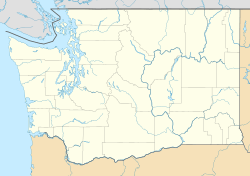Beverly Railroad Bridge facts for kids
Quick facts for kids Beverly Railroad Bridge |
|
|---|---|
 |
|
| Carries | trains |
| Crosses | Columbia River |
| Locale | Beverly, Washington |
| Heritage status | NRHP |
| Characteristics | |
| Design | Warren deck trusses, Parker through truss (main span), and deck plate girders (approaches) |
| Material | Steel |
| History | |
| Construction end | 1909 |
|
Beverly Railroad Bridge
|
|
| Location | Crosses the Columbia River, Grant / Kittitas counties, Washington |
| Nearest city | Beverly, Washington |
| Built | 1909 |
| Architect | Pennsylvania Steel Company |
| Architectural style | Warren deck truss, Parker through truss |
| MPS | Historic Bridges/Tunnels in Washington State TR |
| NRHP reference No. | 82004214 |
| Added to NRHP | July 16, 1982 |
The Beverly Railroad Bridge is a historic bridge that crosses the Columbia River in Washington State. It was built in 1909 for a railroad company called The Milwaukee Road. Today, it's being fixed up to become part of a walking and biking trail.
Contents
Building a Railroad Across America
The Beverly Railroad Bridge was built by the Chicago, Milwaukee, St. Paul and Pacific Railroad, often called The Milwaukee Road. In 1906, this company started building a very long train track. This track would go all the way from Chicago, Illinois to Tacoma, Washington. The entire track was finished three years later, in 1909. The Beverly Railroad Bridge was an important part of this huge project.
How the Bridge Was Built
The bridge crosses over the wide Columbia River. It was built on strong concrete supports called piers. These piers are about 85 feet (26 meters) above the water. This height allows boats and other river traffic to pass underneath safely.
Bridge Design
The bridge uses different types of strong steel structures called trusses.
- It has 14 Warren deck trusses. These are like a zig-zag pattern of triangles that support the train tracks from below.
- There is one Parker through truss. This type of truss forms a tunnel that the train goes through.
- The parts of the bridge leading up to the main section are made of deck plate girders. These are strong, flat steel beams.
Electric Trains
In the 1920s, the railroad started using electric trains. To power these trains, special supports were added to the bridge. These supports held up the catenary, which are the wires that provide electricity to the trains.
What Happened Next
In 1972, the railroad stopped using electric trains. The electric wires (catenary) were taken down from the bridge, but the supports for them were left in place.
Later, in the mid-1970s, The Milwaukee Road company went out of business. In 1980, they stopped using their train lines in the Pacific Northwest. The State of Washington then took over the bridge and the land around it. This happened because the railroad owed back taxes to the state.
A Historic Landmark
The Beverly Railroad Bridge is a very important structure. In 1982, it was added to the National Register of Historic Places. This is a list of places in the United States that are important to history. The bridge was added because it was a key part of The Milwaukee Road's history.
The Bridge Today
Today, the bridge is part of the Palouse to Cascades State Park Trail. This trail follows the old Milwaukee Road train route across Washington State. The bridge is currently being repaired and updated. It is planned to open for people to use for walking and biking in the summer of 2021.
Further Reading
- Soderberg, Lisa. Beverly Railroad Bridge. HAER Inventory, Historic American Engineering Record. Washington, D.C.: U.S. Department of the Interior, 1979.
- Soderberg, Lisa. Historic Bridges and Tunnels in Washington State Thematic Resources. National Register of Historic Places Inventory - Nomination Form. On file at the National Park Service, Washington DC.


